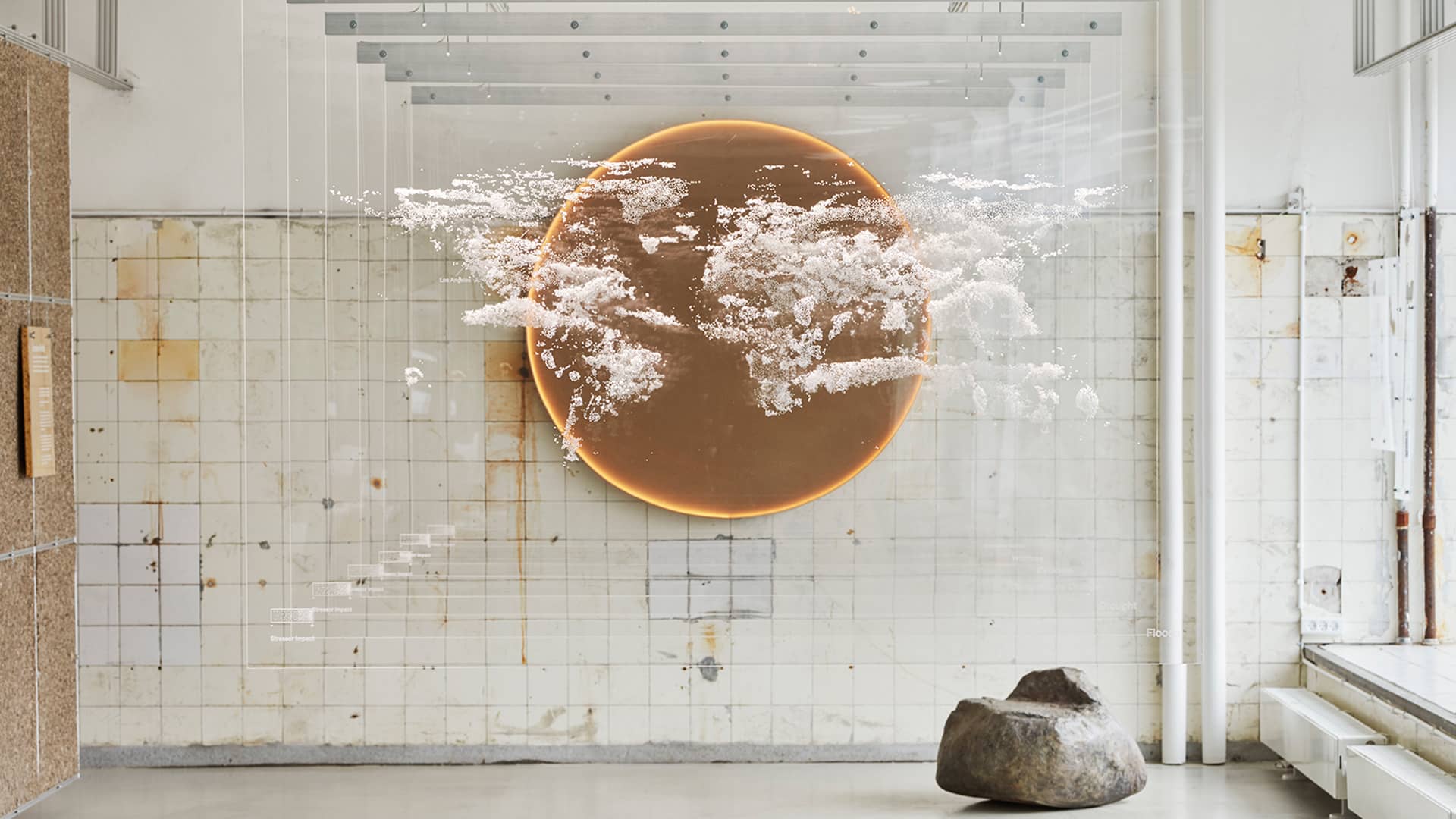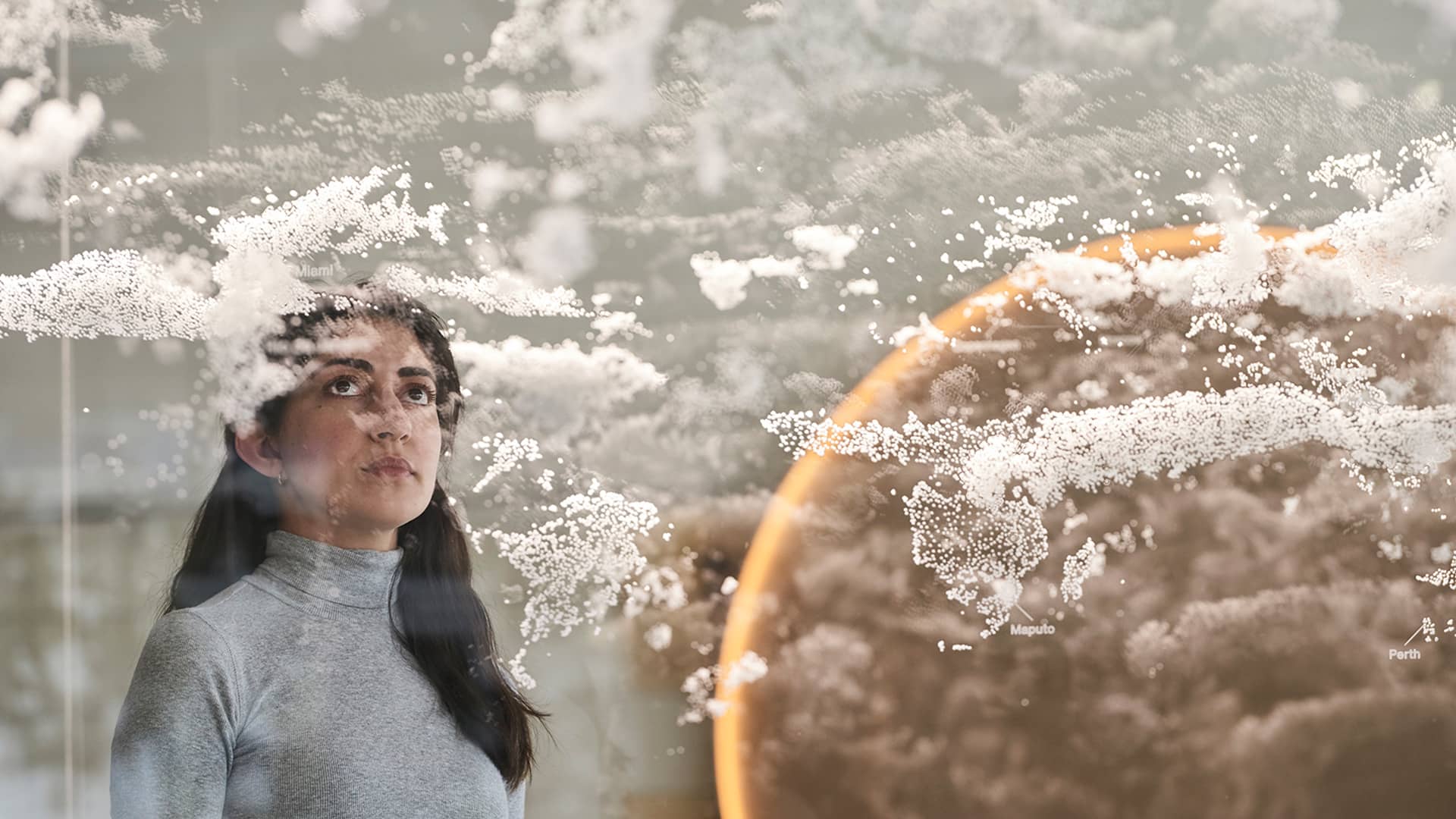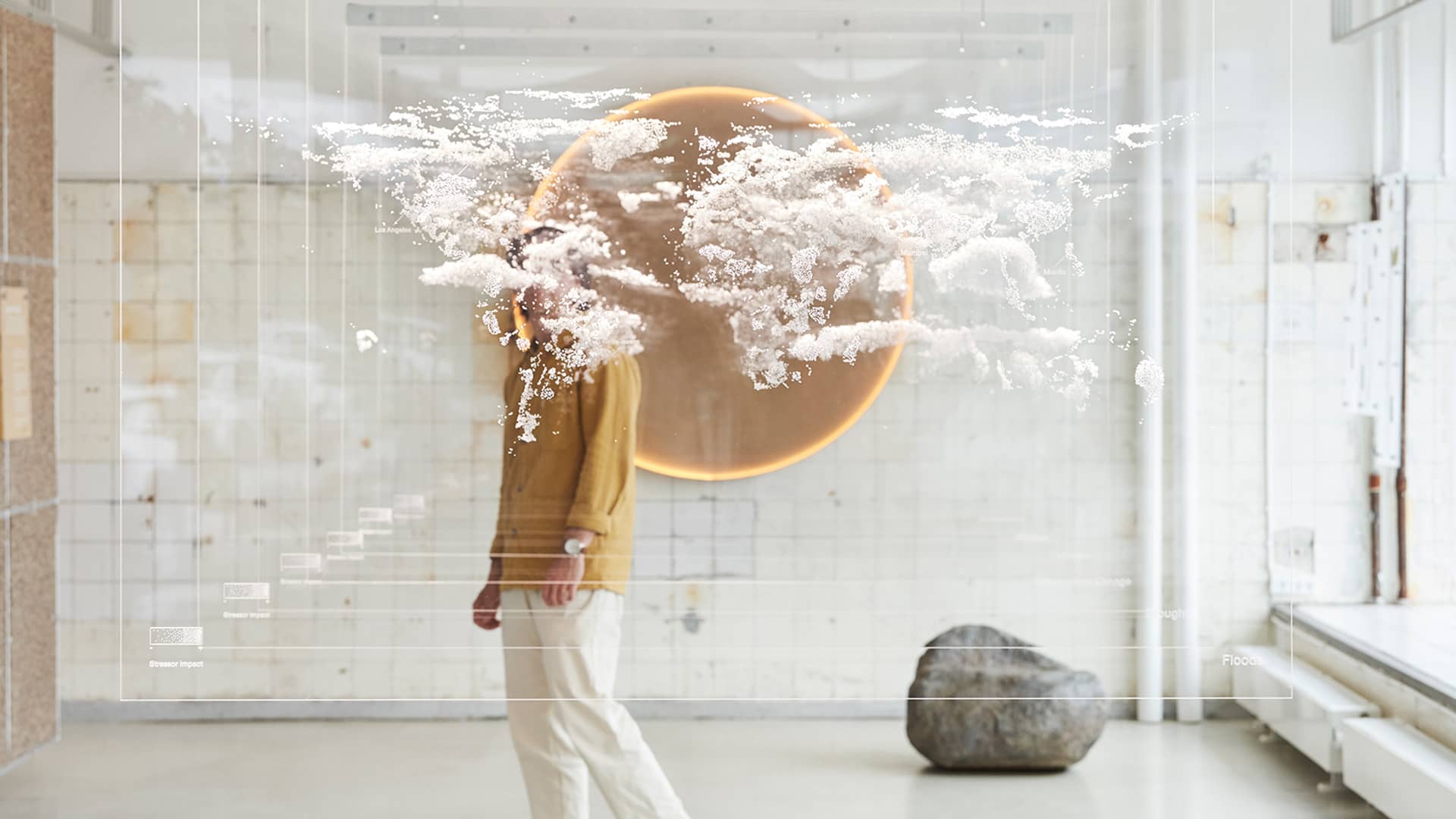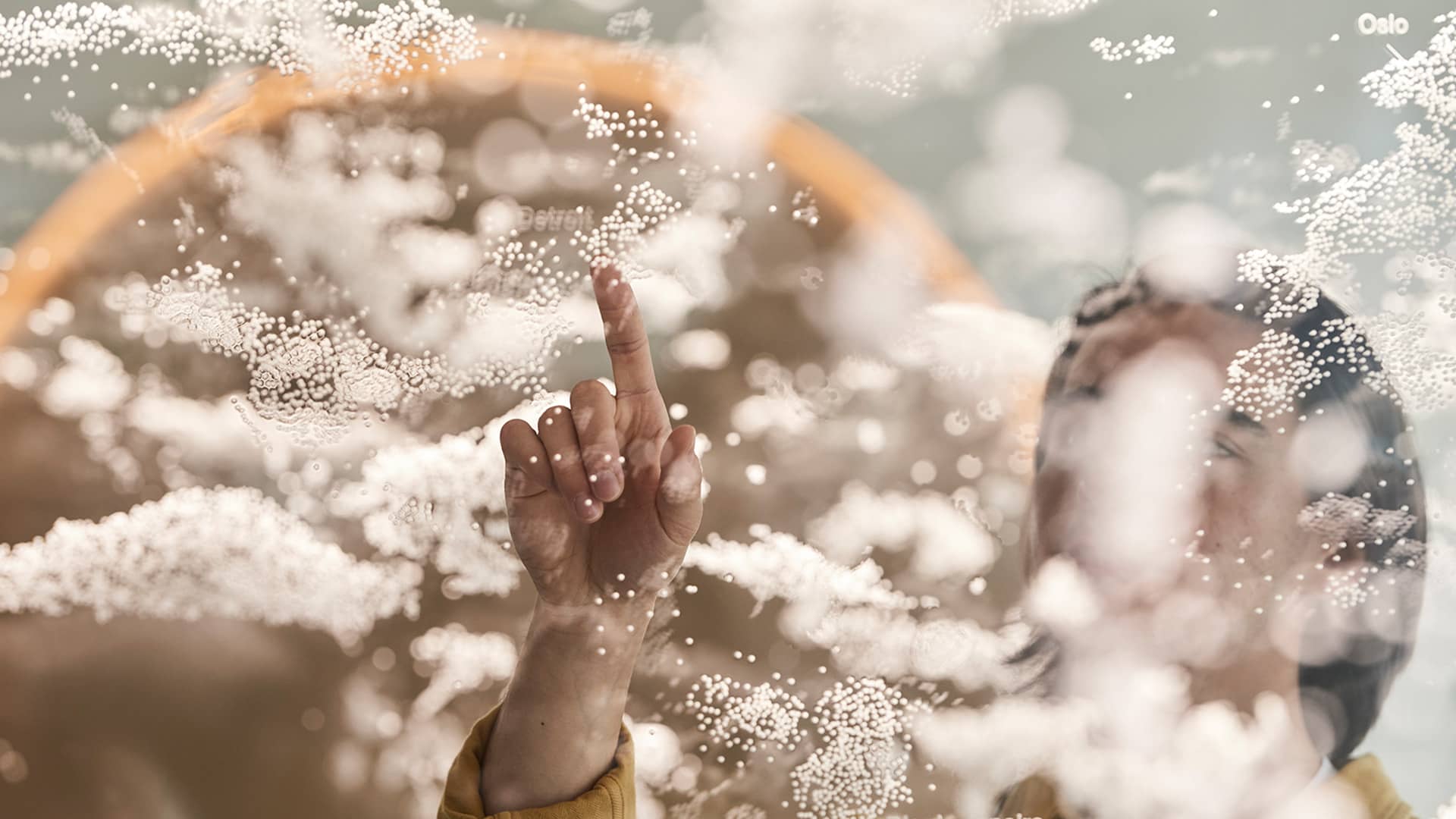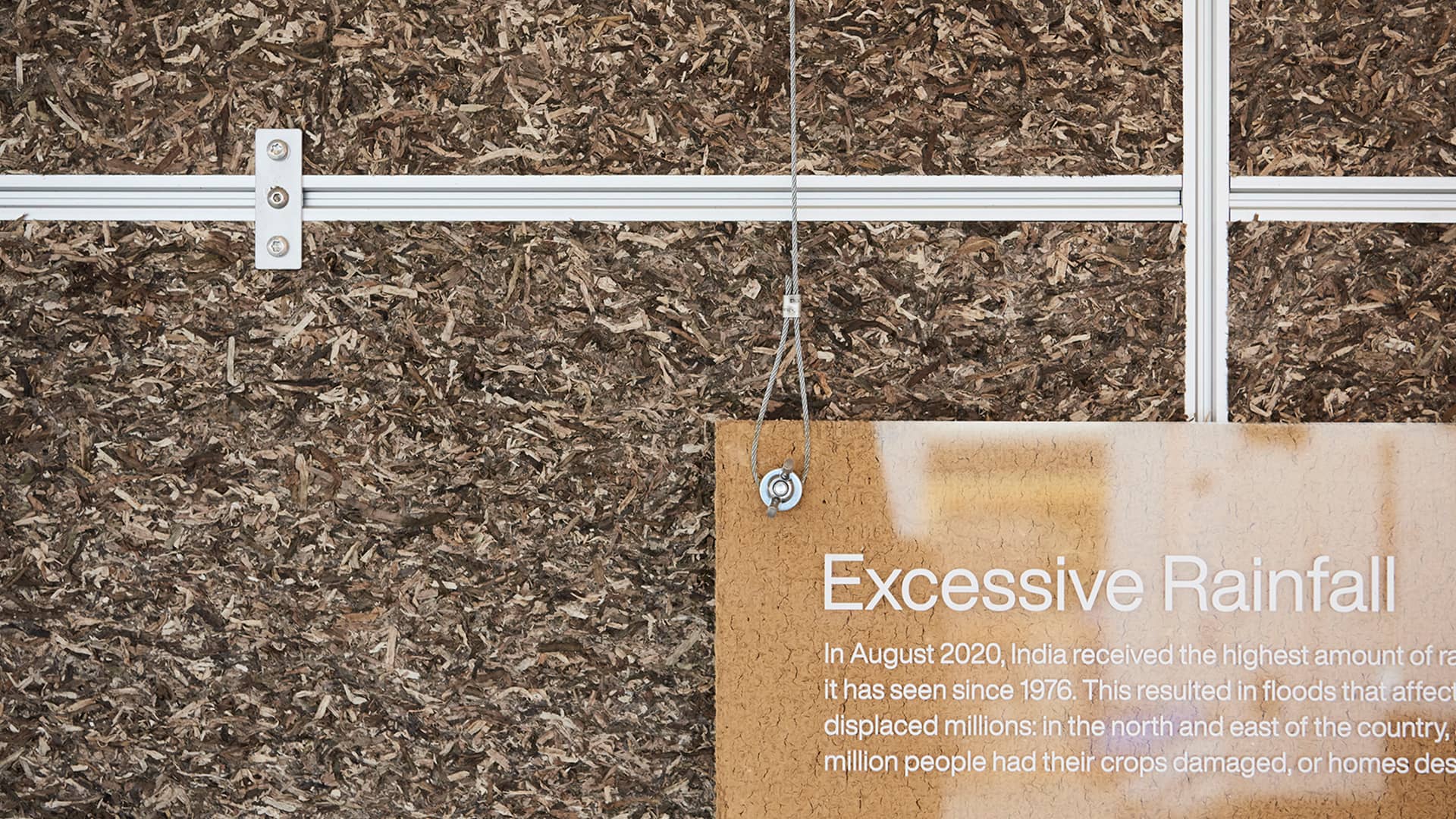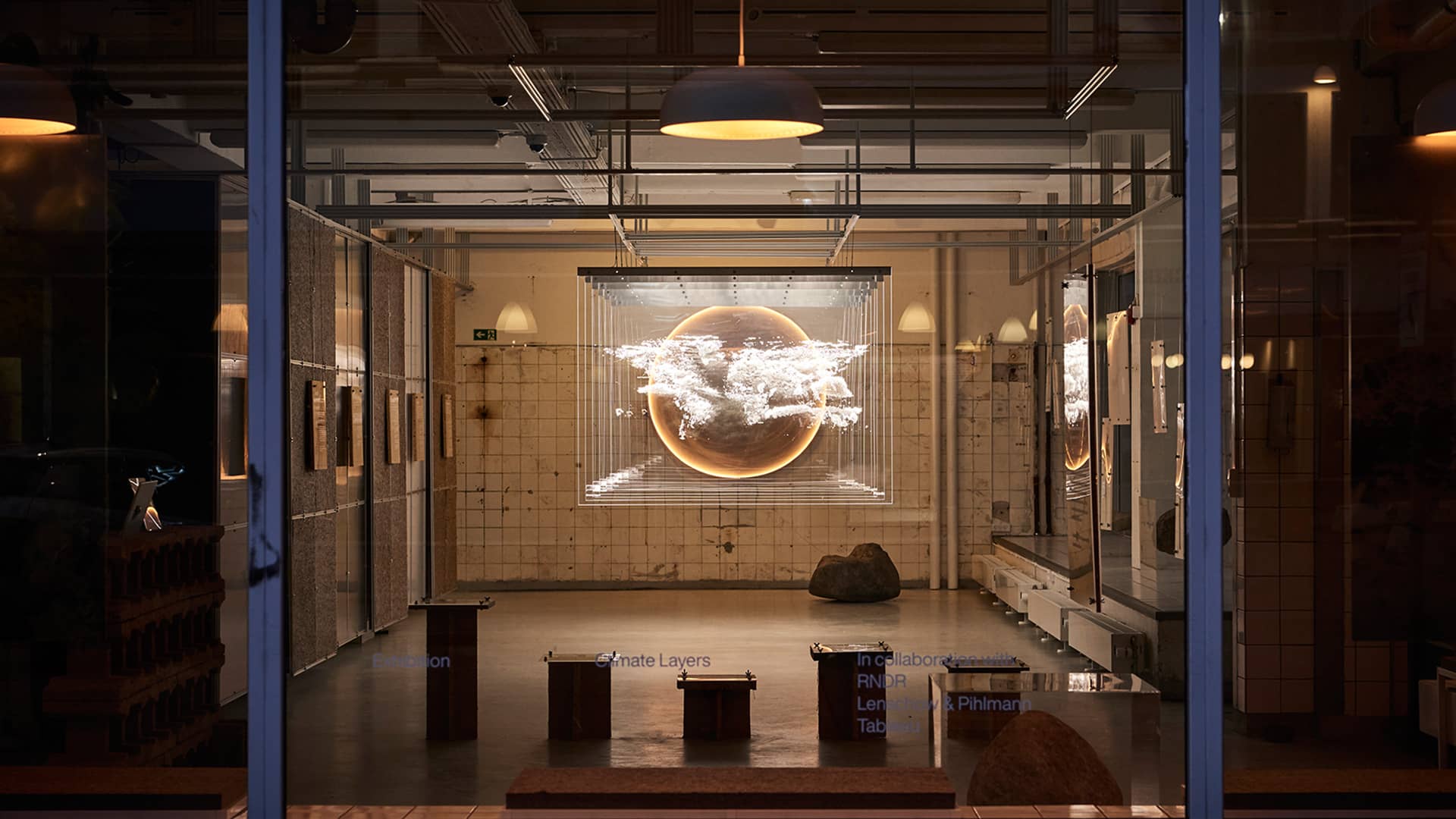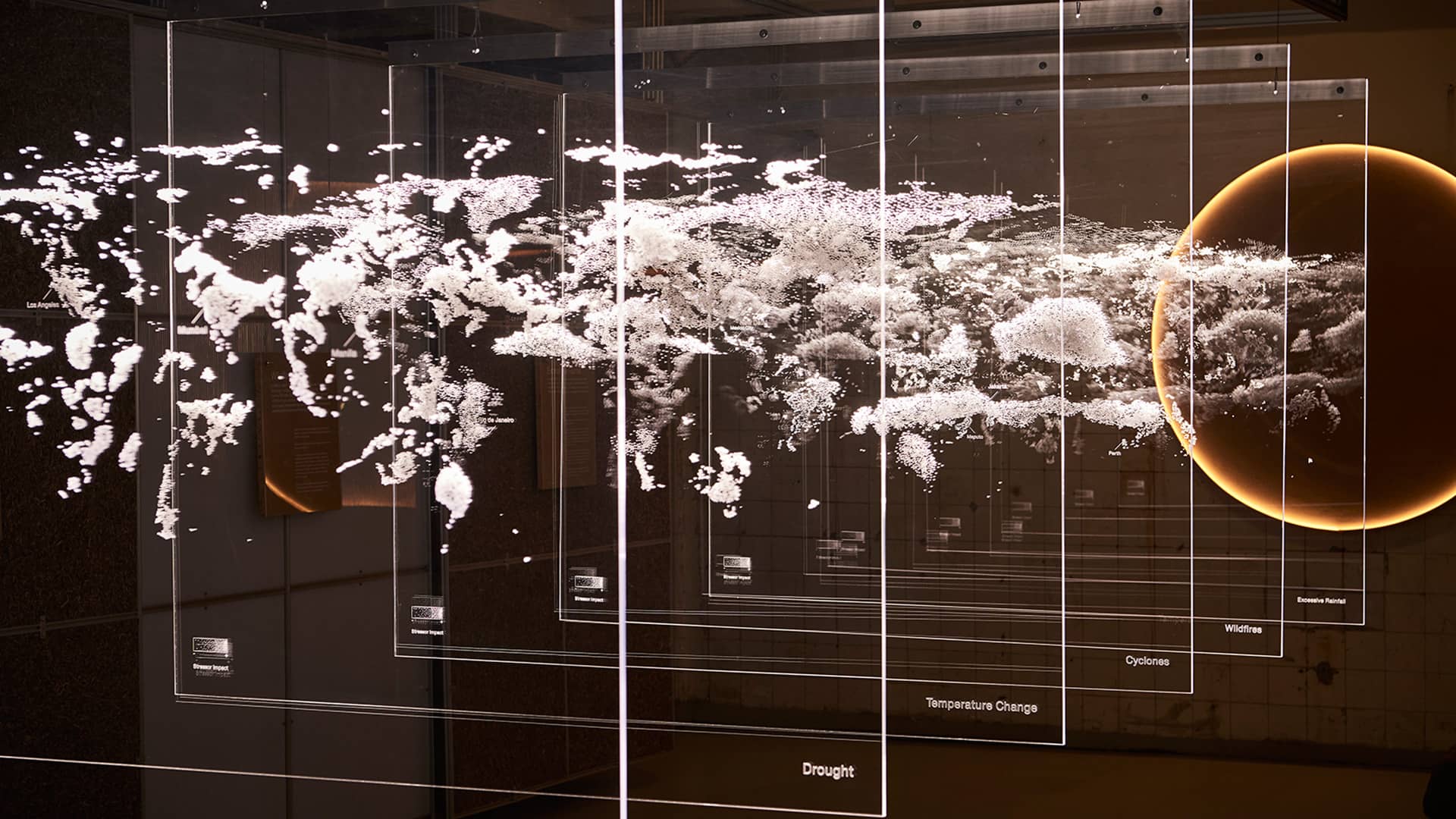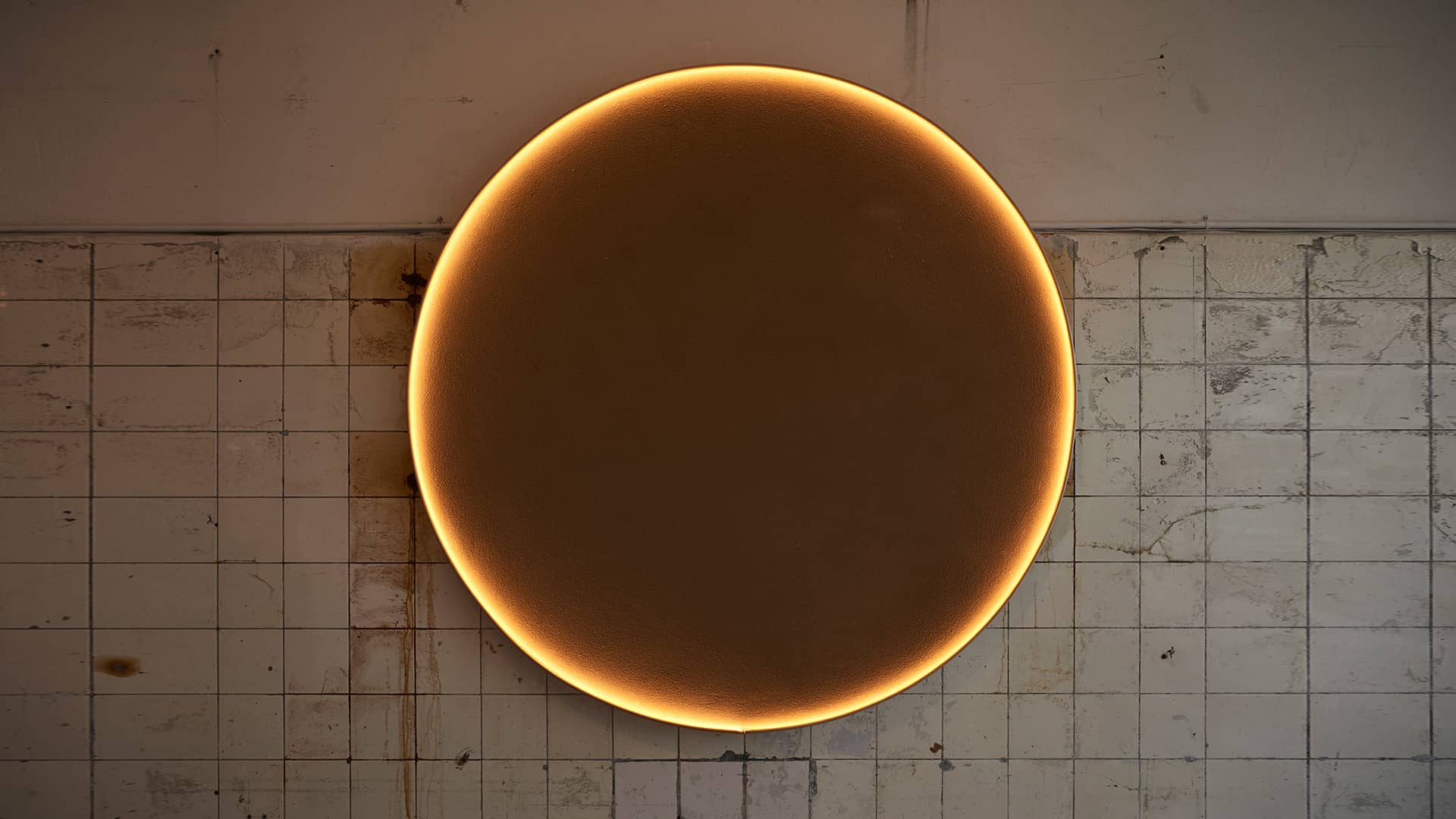On 25 May 2021, SPACE10 opened its doors to the public with an exhibition that visually explores the world as we know it through the lens of climate stressors. With input from Inviso and advisor Charles Iceland from the World Resources Institute, data is exhibited to convey the recent effects of climate stressors on our environment. The exhibition also speaks to the collective need to preserve nature and showcases partners and materials that represent a positive solution-oriented future.
“We focused our new exhibition on climate stressors as they are clear and tangible indicators of the climate crisis. Our aim is to visualize this data to help people better understand how our local and global home looks today - and how it may look tomorrow. In the exhibition, we chose to use new and innovative materials that represent a better way forward. It serves as a reminder that we have the capacity to do things differently from here," says Kevin Curran, Spatial Design Lead, SPACE10.
Climate stressors are natural events like wildfires, floods and droughts that are exacerbated as a result of human emissions. These climate stressors are becoming more frequent and more severe as a result. The exhibition gathers, curates and visualises data sets from the likes of the World Bank and the U.S. National Aeronautics and Space Administration, to show the impact of six climate stressors including cyclones, drought, excessive rainfall, floods, temperature change, and wildfires.
Within the gallery, climate stressors are visualised as a row of layered panels, each defining a different stressor and the impact it had on the world in 2019. The panels are projected as abstract world maps that are laser cut on recycled acrylic sheets hanging from the ceiling. When viewed together, the panels portray the total impact of recent stressors on the planet. In the background, an illuminated globe serves as a backdrop to the panels. For the window display, Tableau created a flower arrangement preserved between recycled acrylic sheets. The scene reminds us that the preservation of our planet is key and that nature is something we need to care for and cherish. Other layers include the effects humans have on nature, including the “Rockin Rock” - a perfect replica of a stone altered by humans to make it more comfortable to sit on.
When curating Climate Layers, SPACE10 took special care to work with new sustainable materials. These include Lehmbauplatten boards made of sand, hemp fibres and clay, as well as upcycled eelgrass acoustic products from Søuld. The panels are made from 100% recycled acrylic from Green Cast and are also 100% recyclable. Other recycled materials and timber industry by-products were used from Durisol and Amroc.
Hand in hand with the exhibition, SPACE10 spoke with two generations of climate advocates: American environmentalist Bill McKibben and Mexican-Chilean climate activist Xiye Bastida, to discuss the current problems we face, and how we can address them together. The conversation is included in the exhibition for people to read.
"I think the reason that we often feel despair is that we’ve been raised to believe that we need to deal with problems ourselves. The pandemic reminded us that really the most powerful force in the world is social solidarity," sharesBill McKibben, Climate Writer and Activist.
The exhibition opens on Tuesday, 25 May 2021, and the public can visit between Tuesday-Friday from 9.00 - 16.00. Due to restrictions, the exhibition will be open to 30 people at a time, with a negative corona test/corona pass.
About:
SPACE10 is a research and design lab on a mission to create a better everyday life for people and the planet. SPACE10 researches and designs innovative solutions to some of the major shifts expected to affect people and our planet in the years to come. SPACE10 is proudly supported by and entirely dedicated to IKEA.
Charles Iceland directs global and national water initiatives at the World Resources Institute (WRI). He has spent the past few years examining the links between water, the climate crisis, and human security, focusing on the developing world. Prior to this, he helped launch and develop the WRI-Aqueduct suite of online global water risk assessment tools. Charles hopes through his work to help people, governments, and companies better cope with water scarcity, drought, and flood challenges.
Inviso by Devoteam is a data consultancy that aims to show organisations how to blend and visualise data into valuable insights. Inviso has 90+ data experts advising people on using data to optimise their work. Inviso believes that you will gain the most innovative and valuable insights through natural curiosity, and by keeping an open mind when working with data processes.
RNDR is a design studio for interactive media that uses code as their primary tool. They develop processes, create structures, design visualisations, code programs, and create interactions. The end result can manifest itself across different media, ranging from interactive installations, data visualisations and generative identities, to prints and everything in between – often in real-time. They are triggered by how information and technology transform networks, cultures, societies, relationships, behaviours, and interactions between people. Their work explores hybrid spaces as it embraces both the digital and the physical. RNDR was founded in 2017 in The Hague, (NL).
Tableau is Copenhagen based multidisciplinary studio and concept store focusing on set design, curating of art, floral installations, spatial and product design.
Lenschow & Pihlmann is a Copenhagen based architecture firm.
On 25 May 2021, SPACE10 opened its doors to the public with an exhibition that visually explores the world as we know it through the lens of climate stressors. With input from Inviso and advisor Charles Iceland from the World Resources Institute, data is exhibited to convey the recent effects of climate stressors on our environment. The exhibition also speaks to the collective need to preserve nature and showcases partners and materials that represent a positive solution-oriented future.
“We focused our new exhibition on climate stressors as they are clear and tangible indicators of the climate crisis. Our aim is to visualize this data to help people better understand how our local and global home looks today - and how it may look tomorrow. In the exhibition, we chose to use new and innovative materials that represent a better way forward. It serves as a reminder that we have the capacity to do things differently from here," says Kevin Curran, Spatial Design Lead, SPACE10.
Climate stressors are natural events like wildfires, floods and droughts that are exacerbated as a result of human emissions. These climate stressors are becoming more frequent and more severe as a result. The exhibition gathers, curates and visualises data sets from the likes of the World Bank and the U.S. National Aeronautics and Space Administration, to show the impact of six climate stressors including cyclones, drought, excessive rainfall, floods, temperature change, and wildfires.
Within the gallery, climate stressors are visualised as a row of layered panels, each defining a different stressor and the impact it had on the world in 2019. The panels are projected as abstract world maps that are laser cut on recycled acrylic sheets hanging from the ceiling. When viewed together, the panels portray the total impact of recent stressors on the planet. In the background, an illuminated globe serves as a backdrop to the panels. For the window display, Tableau created a flower arrangement preserved between recycled acrylic sheets. The scene reminds us that the preservation of our planet is key and that nature is something we need to care for and cherish. Other layers include the effects humans have on nature, including the “Rockin Rock” - a perfect replica of a stone altered by humans to make it more comfortable to sit on.
When curating Climate Layers, SPACE10 took special care to work with new sustainable materials. These include Lehmbauplatten boards made of sand, hemp fibres and clay, as well as upcycled eelgrass acoustic products from Søuld. The panels are made from 100% recycled acrylic from Green Cast and are also 100% recyclable. Other recycled materials and timber industry by-products were used from Durisol and Amroc.
Hand in hand with the exhibition, SPACE10 spoke with two generations of climate advocates: American environmentalist Bill McKibben and Mexican-Chilean climate activist Xiye Bastida, to discuss the current problems we face, and how we can address them together. The conversation is included in the exhibition for people to read.
"I think the reason that we often feel despair is that we’ve been raised to believe that we need to deal with problems ourselves. The pandemic reminded us that really the most powerful force in the world is social solidarity," sharesBill McKibben, Climate Writer and Activist.
The exhibition opens on Tuesday, 25 May 2021, and the public can visit between Tuesday-Friday from 9.00 - 16.00. Due to restrictions, the exhibition will be open to 30 people at a time, with a negative corona test/corona pass.
About:
SPACE10 is a research and design lab on a mission to create a better everyday life for people and the planet. SPACE10 researches and designs innovative solutions to some of the major shifts expected to affect people and our planet in the years to come. SPACE10 is proudly supported by and entirely dedicated to IKEA.
Charles Iceland directs global and national water initiatives at the World Resources Institute (WRI). He has spent the past few years examining the links between water, the climate crisis, and human security, focusing on the developing world. Prior to this, he helped launch and develop the WRI-Aqueduct suite of online global water risk assessment tools. Charles hopes through his work to help people, governments, and companies better cope with water scarcity, drought, and flood challenges.
Inviso by Devoteam is a data consultancy that aims to show organisations how to blend and visualise data into valuable insights. Inviso has 90+ data experts advising people on using data to optimise their work. Inviso believes that you will gain the most innovative and valuable insights through natural curiosity, and by keeping an open mind when working with data processes.
RNDR is a design studio for interactive media that uses code as their primary tool. They develop processes, create structures, design visualisations, code programs, and create interactions. The end result can manifest itself across different media, ranging from interactive installations, data visualisations and generative identities, to prints and everything in between – often in real-time. They are triggered by how information and technology transform networks, cultures, societies, relationships, behaviours, and interactions between people. Their work explores hybrid spaces as it embraces both the digital and the physical. RNDR was founded in 2017 in The Hague, (NL).
Tableau is Copenhagen based multidisciplinary studio and concept store focusing on set design, curating of art, floral installations, spatial and product design.
Lenschow & Pihlmann is a Copenhagen based architecture firm.
On 25 May 2021, SPACE10 opened its doors to the public with an exhibition that visually explores the world as we know it through the lens of climate stressors. With input from Inviso and advisor Charles Iceland from the World Resources Institute, data is exhibited to convey the recent effects of climate stressors on our environment. The exhibition also speaks to the collective need to preserve nature and showcases partners and materials that represent a positive solution-oriented future.
“We focused our new exhibition on climate stressors as they are clear and tangible indicators of the climate crisis. Our aim is to visualize this data to help people better understand how our local and global home looks today - and how it may look tomorrow. In the exhibition, we chose to use new and innovative materials that represent a better way forward. It serves as a reminder that we have the capacity to do things differently from here," says Kevin Curran, Spatial Design Lead, SPACE10.
Climate stressors are natural events like wildfires, floods and droughts that are exacerbated as a result of human emissions. These climate stressors are becoming more frequent and more severe as a result. The exhibition gathers, curates and visualises data sets from the likes of the World Bank and the U.S. National Aeronautics and Space Administration, to show the impact of six climate stressors including cyclones, drought, excessive rainfall, floods, temperature change, and wildfires.
Within the gallery, climate stressors are visualised as a row of layered panels, each defining a different stressor and the impact it had on the world in 2019. The panels are projected as abstract world maps that are laser cut on recycled acrylic sheets hanging from the ceiling. When viewed together, the panels portray the total impact of recent stressors on the planet. In the background, an illuminated globe serves as a backdrop to the panels. For the window display, Tableau created a flower arrangement preserved between recycled acrylic sheets. The scene reminds us that the preservation of our planet is key and that nature is something we need to care for and cherish. Other layers include the effects humans have on nature, including the “Rockin Rock” - a perfect replica of a stone altered by humans to make it more comfortable to sit on.
When curating Climate Layers, SPACE10 took special care to work with new sustainable materials. These include Lehmbauplatten boards made of sand, hemp fibres and clay, as well as upcycled eelgrass acoustic products from Søuld. The panels are made from 100% recycled acrylic from Green Cast and are also 100% recyclable. Other recycled materials and timber industry by-products were used from Durisol and Amroc.
Hand in hand with the exhibition, SPACE10 spoke with two generations of climate advocates: American environmentalist Bill McKibben and Mexican-Chilean climate activist Xiye Bastida, to discuss the current problems we face, and how we can address them together. The conversation is included in the exhibition for people to read.
"I think the reason that we often feel despair is that we’ve been raised to believe that we need to deal with problems ourselves. The pandemic reminded us that really the most powerful force in the world is social solidarity," sharesBill McKibben, Climate Writer and Activist.
The exhibition opens on Tuesday, 25 May 2021, and the public can visit between Tuesday-Friday from 9.00 - 16.00. Due to restrictions, the exhibition will be open to 30 people at a time, with a negative corona test/corona pass.
About:
SPACE10 is a research and design lab on a mission to create a better everyday life for people and the planet. SPACE10 researches and designs innovative solutions to some of the major shifts expected to affect people and our planet in the years to come. SPACE10 is proudly supported by and entirely dedicated to IKEA.
Charles Iceland directs global and national water initiatives at the World Resources Institute (WRI). He has spent the past few years examining the links between water, the climate crisis, and human security, focusing on the developing world. Prior to this, he helped launch and develop the WRI-Aqueduct suite of online global water risk assessment tools. Charles hopes through his work to help people, governments, and companies better cope with water scarcity, drought, and flood challenges.
Inviso by Devoteam is a data consultancy that aims to show organisations how to blend and visualise data into valuable insights. Inviso has 90+ data experts advising people on using data to optimise their work. Inviso believes that you will gain the most innovative and valuable insights through natural curiosity, and by keeping an open mind when working with data processes.
RNDR is a design studio for interactive media that uses code as their primary tool. They develop processes, create structures, design visualisations, code programs, and create interactions. The end result can manifest itself across different media, ranging from interactive installations, data visualisations and generative identities, to prints and everything in between – often in real-time. They are triggered by how information and technology transform networks, cultures, societies, relationships, behaviours, and interactions between people. Their work explores hybrid spaces as it embraces both the digital and the physical. RNDR was founded in 2017 in The Hague, (NL).
Tableau is Copenhagen based multidisciplinary studio and concept store focusing on set design, curating of art, floral installations, spatial and product design.
Lenschow & Pihlmann is a Copenhagen based architecture firm.







 Sign in with email
Sign in with email


